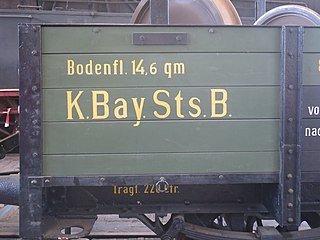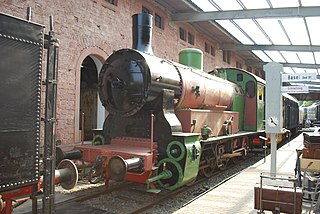
The Royal Bavarian State Railways was the state railway company for the Kingdom of Bavaria. It was founded in 1844. The organisation grew into the second largest of the German state railways with a railway network of 8,526 kilometres by the end of the First World War.

The Bavarian Class Gt 2×4/4 engine of the Royal Bavarian State Railways, was a heavy goods train tank locomotive of the Mallet type. It was later designated the DRG Class 96 by the DRG, DB and DR.
Locomotives 9 and 10 of the Lokalbahn AG (LAG) were saturated steam locomotives that were built for the Murnau - Garmisch-Partenkirchen route opened in 1889.

The locomotives of DRG Class 98.10 were superheated steam locomotives with the Deutsche Reichsbahn-Gesellschaft.

The Bavarian Class GtL 4/4 engines were superheated steam locomotives in service with the Royal Bavarian State Railways for duties on branch lines (Lokalbahnen).

The Bavarian Class D XII steam locomotives were manufactured by the firm of Krauss from 1897 for the Royal Bavarian State Railways. Ninety six of them were procured for service on the stub lines running from Munich into the mountains, but in reality they were stationed in many large Bavarian locomotive depots. Two engines were transferred to the Palatinate Railway (Pfalzbahn) in 1916, the remaining 94 later joined the Deutsche Reichsbahn fleet and were incorporated as DRG Class 73.0-1 with operating numbers 73 031–124.

The six-coupled P 5 of the Palatinate Railway (Pfalzbahn) was to replace the four-coupled locomotives in the Palatinate. They were given a leading Krauss-Helmholtz bogie and a trailing bogie in order to achieve satisfactory weight distribution.

The Einheitsdampflokomotiven, sometimes shortened to Einheitslokomotiven or Einheitsloks, were the standardized steam locomotives built in Germany after 1925 under the direction of the Deutsche Reichsbahn-Gesellschaft. Their manufacture made extensive use of standard design features and components.
The Bavarian engines with railway numbers 87 and 88 were superheated steam locomotives with the Localbahn AG (LAG). They were the last two engines that the LAG procured because shortly after their delivery in 1937, the company was finally nationalised. The locomotives were largely similar in their design to the TAG 7 locomotive, that had been developed in 1936 by Krauss-Maffei for the Tegernsee Railway AG. TAG 7 were the last branch line (Lokalbahn) locomotives to be designed and built in Bavaria. Unlike the two LAG engines, TAG 7 survived, first as the operating reserve for the Tegernseebahn and later as a museum locomotive. It is maintained by the Bavarian Localbahn Society and regularly used for museum trips around Munich.

The Prussian T 18 was the last class of tank locomotives developed for the Prussian state railways. They were originally intended for services on the island of Rügen as replacements for Class T 12 and T 10 engines. They emerged when a class of locomotive was conceived in 1912 that was to handle express and passenger trains in border areas or in shuttle services on short routes. A tank engine design with symmetrical running gear was envisaged because, unlike a tender locomotive, it could run equally fast forwards and backwards and could be operated on return journeys without having to be turned on a turntable. Its power and top speed were to be the same as those of the P 8. Robert Garbe designed this 4-6-4 (2′C2′) tank locomotive for 100 km/h with a 17-ton axle load and contracted the Vulkan Werke in Stettin to build it. It was given the designation T 18.

Between 1934 and 1941 the Deutsche Reichsbahn (DRG) converted a total of 691 former Prussian-built Class 55.25–56 steam locomotives; the result was the DRG Class 56.2–8. The carrying axle enabled higher speeds and the engine could even be used as a passenger train locomotive. In addition the average axle load was lower, so that these locomotives could also be used on branch lines. The conversion entailed moving the boiler forward and raising it somewhat. The vehicles were given operating numbers between 56 201 and 56 891, although the numbering was not continuous.

The DRG Class ET 85 was a German electric motor coach with the Deutsche Reichsbahn and, later, the Deutsche Bundesbahn.

The electric locomotives of Bavarian Class EP 2 were in light passenger train service in Germany for almost 50 years. After their initial classification as EP 2 by the Royal Bavarian State Railways, they were redesignated as E 32s from 1927 to 1968 in the DRG's numbering plan and, later in the DB classification scheme. In their final years, post-1968, they were given the EDV-compatible classification of 132. Characteristic of the E 32 was its short length and link drive (Stangenantrieb).

The Bavarian Class EP 5 was an electric locomotive used for heavy passenger train services with the Deutsche Reichsbahn (DRG) and Deutsche Bundesbahn (DB).
Three different types of German electric goods train locomotive belonged to the Deutsche Reichsbahn's DRG Class E 91. In addition to the standard locomotives (Einheitslokomotive) described below there was also a Prussian class that was given the designation E 913 in 1927.
The DRG locomotive classification system was developed by the German Imperial Railway Company or Deutsche Reichsbahn-Gesellschaft (DRG), which was formed in 1924 following the merger of the German state railways (Länderbahnen) in 1920. A common classification and numbering scheme was needed in order to organise effectively the four hundred or so different steam locomotive classes taken over from the state railways, as well as new locomotives. This process lasted until 1926. Only then was the final renumbering plan fixed.

Class T 5 of the Palatinate Railway was a German, goods train, tank locomotive class with five coupled axles and no carrying axles.
The Palatine T 4II was a class of saturated steam, tank locomotives operated by the Palatinate Railway.












